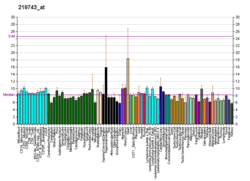Hairy/enhancer-of-split related with YRPW motif protein 2 (HEY2) also known as cardiovascular helix-loop-helix factor 1 (CHF1) is a protein that in humans is encoded by the HEY2 gene. [5] [6]
Contents
- Expression
- Knockout studies
- Clinical significance
- Interactions
- References
- Further reading
- External links
This protein is a type of transcription factor that belongs to the hairy and enhancer of split-related (HESR) family of basic helix-loop-helix (bHLH)-type transcription factors. It forms homo- or hetero-dimers that localize to the nucleus and interact with a histone deacetylase complex to repress transcription. During embryonic development, this mechanism is used to control the number of cells that develop into cardiac progenitor cells and myocardial cells. [7] The relationship is inversely related, so as the number of cells that express the Hey2 gene increases, the more CHF1 is present to repress transcription and the number of cells that take on a myocardial fate decreases. [7]




